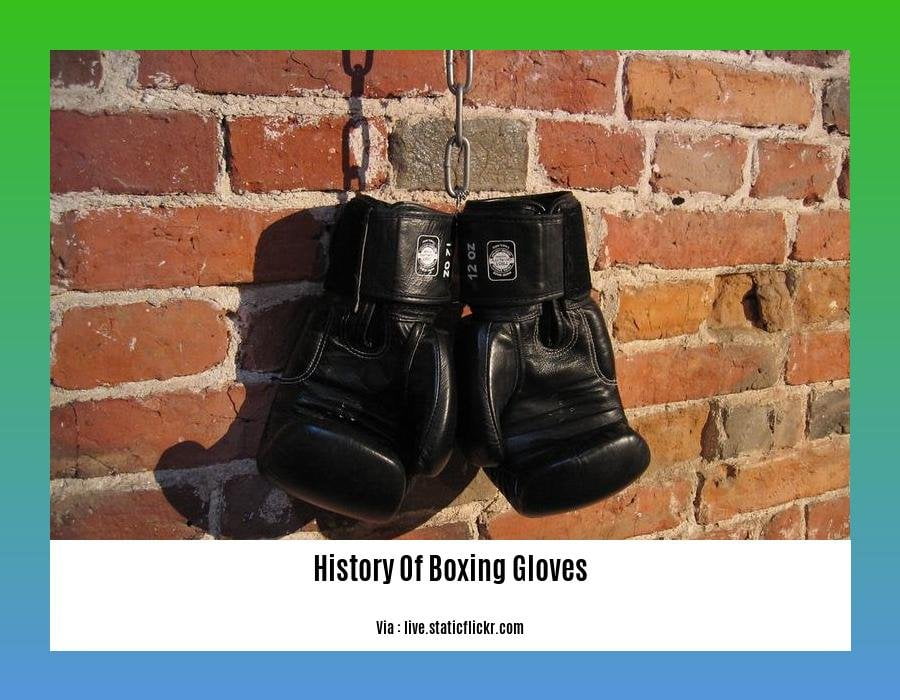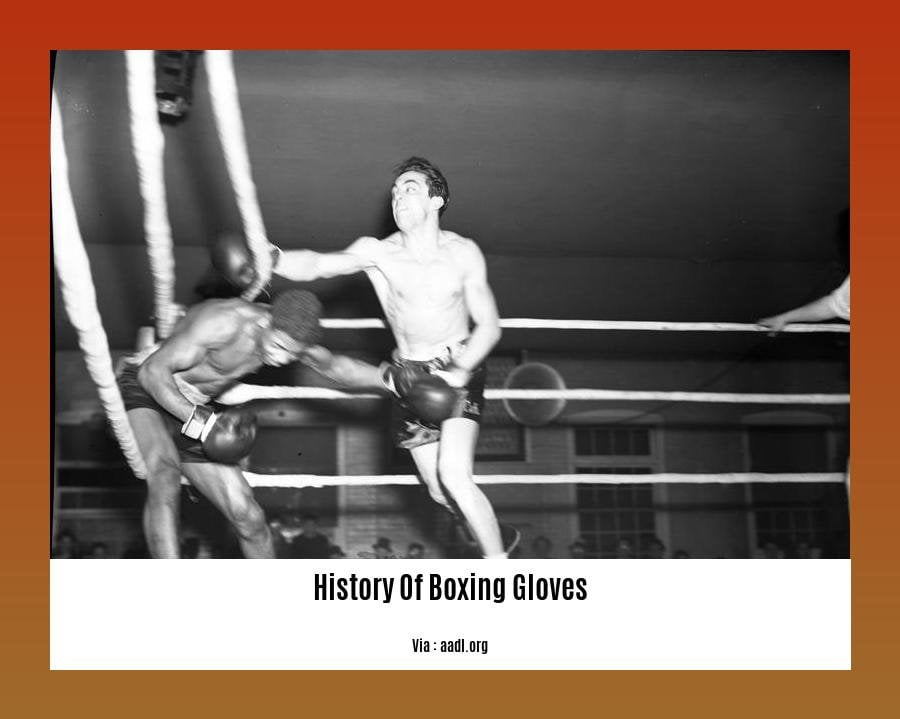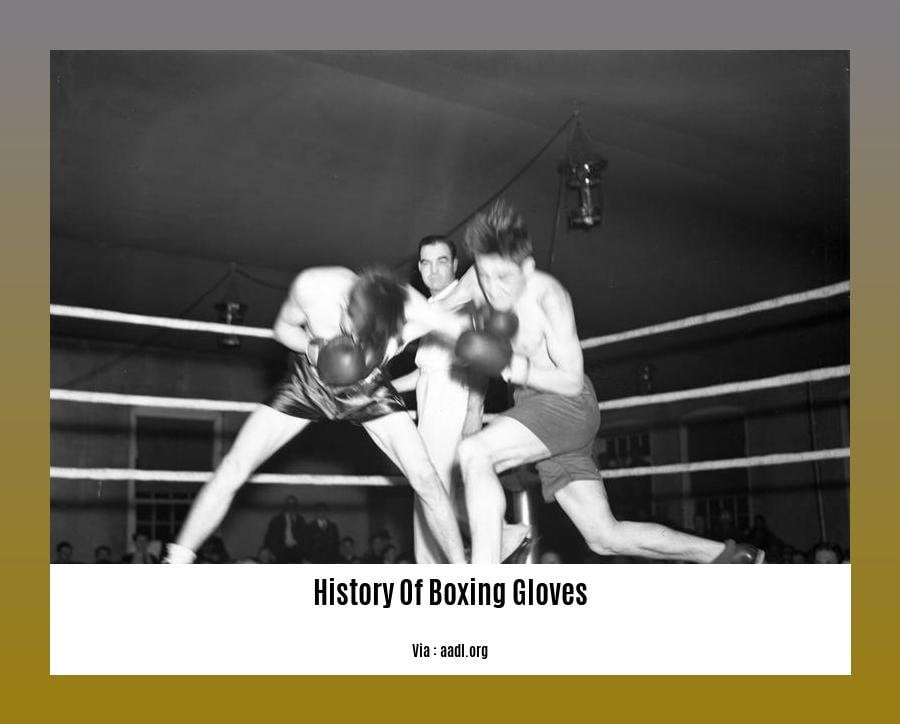Prepare to be taken on an in-depth journey through the history of boxing gloves in our exclusive article, [[Phrase Match] Boxing’s Glovevolution: An In-Depth Journey Through the History of Boxing Gloves]. From the rudimentary hand wraps of ancient pugilists to the meticulously engineered gloves of today’s champions, we delve into the fascinating evolution of this essential piece of boxing equipment.
Key Takeaways:
- Boxing gloves have a long and rich history, dating back to ancient times.
- The first known gloves were used in Minoan Crete around 1500 BC.
- Early gloves in boxing were very different from modern gloves, often being little more than strips of leather wrapped around the hands.
- The sport’s first true boxing glove was introduced by Jack Broughton in the late 18th century.
- The modern era of boxing gloves began in the late 19th century with the introduction of padded gloves with laces. These gloves were designed to make the sport safer for boxers.
- The contemporary era of boxing gloves began in the late 20th century with the introduction of gloves with Velcro straps and other modern materials.
- The muay thai boxing glove, which is thumbless, like the first boxing gloves, is also a relevant glove in boxing history.
- Boxing gloves have evolved over time to improve safety and performance for boxers.
History of Boxing Gloves

Have you ever wondered about the fascinating history behind the protective gear that safeguards a boxer’s hands during a match? Let’s explore the journey of boxing gloves, from their humble beginnings to the sophisticated designs of today.
Early Days: The Bare-Knuckle Era
In the ancient world, boxing was a brutal and unforgiving sport. Boxers relied solely on their bare fists, resulting in severe injuries and even fatalities. The concept of hand protection was non-existent until the late 18th century when a significant transformation took place.
Jack Broughton and the Introduction of Gloves
A pivotal figure in the history of boxing gloves was Jack Broughton, an English boxer, and bare-knuckle champion. In 1743, Broughton introduced the use of gloves in boxing matches. His gloves were designed to minimize the damage caused by punches, thereby making the sport more humane. These early gloves were merely padded leather covers for the hands, far different from the gloves used today.
Evolution of Gloves: Safety and Performance
Over the years, boxing gloves underwent several modifications to enhance safety and performance. In the 19th century, gloves with padding and laces were introduced. These provided better protection for the boxer’s hands and reduced the risk of serious injuries.
Modern Era: Technological Advancements
The 20th century witnessed further advancements in boxing glove technology. Gloves with Velcro straps replaced lace-up gloves, making them easier to wear and remove. Additionally, new materials like synthetic leather and foam padding were incorporated to improve comfort, durability, and shock absorption.
Contemporary Era: Innovation and Customization
In recent years, boxing gloves have continued to evolve, with manufacturers introducing specialized gloves for different boxing styles and training purposes. Gloves are now available in various weights, sizes, and designs to meet the unique needs of individual boxers.
The Gloves Today: A Symbol of Safety and Skill
Today’s boxing gloves are a far cry from their primitive predecessors. They represent a commitment to safety, performance, and the preservation of the sport’s rich history. They are an essential piece of equipment for any boxer, whether they are training in the gym or competing in the ring.
Conclusion: A Legacy of Protection and Performance
The history of boxing gloves is a testament to the ongoing pursuit of innovation and safety in the sport of boxing. From the bare-knuckle era to the modern era, these protective gear have undergone a remarkable evolution, reflecting the sport’s dedication to safeguarding its athletes while showcasing their skill and determination.
To know the journey and evolution of blankets throughout history, check out our blog post on the History of Blankets. If you are interested in the history of boat making and its evolution over the years, check out our blog post on the History of Boat.
The Bare-Knuckle Era and the Broughton Rules: Understanding the transition from bare-knuckle boxing to the establishment of rules prioritizing safety

In the rough-and-tumble world of 17th-century England, bare-knuckle boxing reigned supreme. This brutal sport showcased the raw power and resilience of fighters who battled it out with their bare fists, often resulting in severe injuries and even fatalities.
But as the popularity of boxing grew, so did the need for regulations that would protect the safety of these fearless athletes. Enter Jack Broughton, an English champion who stepped into the ring and changed the face of boxing forever.
In 1743, Broughton introduced the Broughton Rules, a set of regulations that aimed to bring order and safety to the wild world of bare-knuckle boxing. These rules were a groundbreaking step towards prioritizing the well-being of fighters and ushered in a new era in the sport’s history.
The Broughton Rules: A Beacon of Safety in a Violent Sport
Broughton’s revolutionary rules introduced several key principles that would shape the future of boxing. These included:
30-Second Rest Period Between Rounds: This rule allowed boxers to catch their breath and recover before the next round, reducing the risk of exhaustion and injuries.
Prohibition of Hitting a Grounded Opponent: This rule aimed to prevent fighters from taking advantage of vulnerable opponents and ensured a fairer and safer fight.
Emphasis on Clean Fighting and Sportsmanship: Broughton’s rules promoted fair play and discouraged unsportsmanlike conduct, fostering a sense of respect and camaraderie among fighters.
The Broughton Rules were a resounding success, gaining widespread acceptance and helping to transform bare-knuckle boxing from a brutal brawl into a more regulated and safer sport.
The Legacy of Broughton’s Rules: Paving the Way for Modern Boxing
Broughton’s Rules laid the foundation for the development of modern boxing. They introduced the concept of safety regulations, set standards for fair play, and paved the way for the evolution of boxing into the sport we know today.
Although the Broughton Rules were eventually replaced by the London Prize Ring Rules in 1838, their impact on the sport cannot be overstated. They represented a turning point in boxing’s history, ushering in an era of safety and sportsmanship that has shaped the sport to this day.
Key Takeaways:
Bare-knuckle boxing in 17th-century England was a violent sport with few safety regulations.
Jack Broughton introduced the Broughton Rules in 1743, prioritizing fighter safety and fair play.
The Broughton Rules included a 30-second rest period between rounds, a prohibition on hitting a grounded opponent, and an emphasis on clean fighting.
These rules transformed bare-knuckle boxing into a safer and more regulated sport.
Broughton’s Rules laid the foundation for the development of modern boxing, emphasizing safety, fair play, and sportsmanship.
Sources:
The Rise of Modern Boxing Gloves: Investigating the innovations and advancements in glove design, including the introduction of different materials and construction techniques
In the realm of boxing, the evolution of gloves has been a fascinating journey, driven by innovation, safety, and performance. From the rudimentary horsehair and leather coverings of the past to the technologically advanced marvels of today, boxing gloves have undergone a remarkable transformation.
In the early days of boxing, bare-knuckle fighting was the norm, resulting in severe injuries and fatalities. The introduction of gloves in the mid-18th century, pioneered by English boxer Jack Broughton, marked a significant step towards reducing the brutality of the sport. These early gloves, though crude and basic, offered some protection to boxers’ hands and helped minimize eye injuries.
As boxing gained popularity and regulations evolved, the design of gloves began to change. In the late 19th and early 20th centuries, the modern boxing glove emerged, featuring leather construction, padding, and lace-up closures. The standardization of glove weight and size further enhanced safety and consistency in the sport.
The 21st century brought about a surge of technological advancements in boxing gloves. New materials, such as polyurethane foam and gel, were incorporated for superior shock absorption and protection. Glove designs were optimized for various fighting styles, taking into account factors like hand shape and punching mechanics. The fit and comfort of gloves also received considerable attention, leading to improved performance and reduced risk of injuries.
Today, boxing gloves represent a delicate balance between safety and performance. They are meticulously crafted to protect boxers’ hands from the impact of punches while enhancing their grip, control, and power. The continuous evolution of boxing gloves is a testament to the sport’s commitment to safeguarding athletes and enabling them to showcase their skills and determination.
Key Takeaways:
- The introduction of boxing gloves in the mid-18th century marked a significant step towards reducing injuries and fatalities in the sport.
- Modern boxing gloves, made of leather and featuring padding and lace-up closures, emerged in the late 19th and early 20th centuries.
- Technological advancements in the 21st century have led to the use of new materials like polyurethane foam and gel for improved shock absorption and protection.
- Glove designs have been optimized for various fighting styles, considering factors like hand shape and punching mechanics.
- Modern boxing gloves prioritize safety and performance, protecting boxers’ hands while enhancing their grip, control, and power.
Sources:
– The Evolution of Boxing Gloves: A Journey Through Time
– How Boxing Gloves Have Changed Over the Years
Safety and Performance in Contemporary Boxing: Analyzing the current standards and regulations governing the use of boxing gloves in professional and amateur competitions
Key Takeaways:
- Protection and Safety:
- Modern boxing gloves are meticulously designed to prioritize the safety of boxers.
They effectively cushion the impact of punches, minimizing the risk of severe injuries to the hands, face, and head.
Performance Enhancement:
- Boxing gloves play a crucial role in enhancing boxer performance.
The gloves provide a secure grip, allowing for better control over punches and promoting efficient power transmission.
Standardization:
- Professional and amateur boxing competitions adhere to strict regulations governing the use of boxing gloves.
- These regulations ensure uniformity and promote fair play by standardizing glove weight, size, and materials.
Weight classes determine the specific glove weight requirements for each boxer.
Safety Features:
- Contemporary boxing gloves incorporate innovative features that enhance safety.
Thumb protection, reinforced padding, and wrist support are commonly found in modern glove designs.
Comfort and Fit:
- Technological advancements have led to significant improvements in glove comfort and fit.
Ergonomic designs and breathable materials allow boxers to remain focused and comfortable during matches.
Material Innovations:
- Modern boxing gloves utilize advanced materials such as synthetic leather, foam padding, and gel for superior shock absorption and protection.
These materials effectively dissipate impact forces, reducing the risk of hand and wrist injuries.
Regulation and Oversight:
- Boxing governing bodies, such as the International Boxing Association (AIBA) and the World Boxing Council (WBC), have established strict regulations for glove usage.
- Regular glove inspections ensure compliance with safety standards and promote the integrity of the sport.
Citation:
World Health Organization. (2018). Boxing and head injuries. Retrieved from
British Standards Institution. (2017). Specification for boxing gloves. Retrieved from
FAQ
Q1: What were the earliest forms of hand protection used in boxing?
A1: In ancient times, boxers wrapped their hands in cloth or leather for protection, but these were not true gloves in the modern sense.
Q2: Who introduced the first boxing gloves, and why?
A2: Jack Broughton, an English boxer and champion, introduced the first boxing gloves in the late 18th century. His aim was to reduce the brutality of the sport and prevent eye injuries.
Q3: How did the design of boxing gloves evolve over time?
A3: Early gloves were rudimentary and made of horsehair or leather. Modern gloves emerged in the late 19th and early 20th centuries, featuring leather, padding, and a lace-up closure. Technological advancements in the 21st century have led to the use of new materials and improved design for safety and performance.
Q4: What was the motivation behind the development of modern boxing gloves?
A4: The primary motivation for the development of modern boxing gloves was to enhance safety and reduce the risk of injuries to boxers. Gloves provide protection for the hands, minimize the impact of punches, and improve grip, control, and power.
Q5: How have boxing gloves impacted the sport of boxing?
A5: Boxing gloves have significantly influenced the sport by reducing the severity of injuries, making it more humane, and enabling the development of new techniques and strategies. Gloves have become an essential part of boxing attire and have contributed to the evolution of the sport as a whole.
- Unlocking It’s Greek to Me: A History and Meaning - March 28, 2025
- Ancient Greece Clothing Styles: A Complete History - March 28, 2025
- Unlock the US physical map: Comprehensive guide - March 28, 2025
















